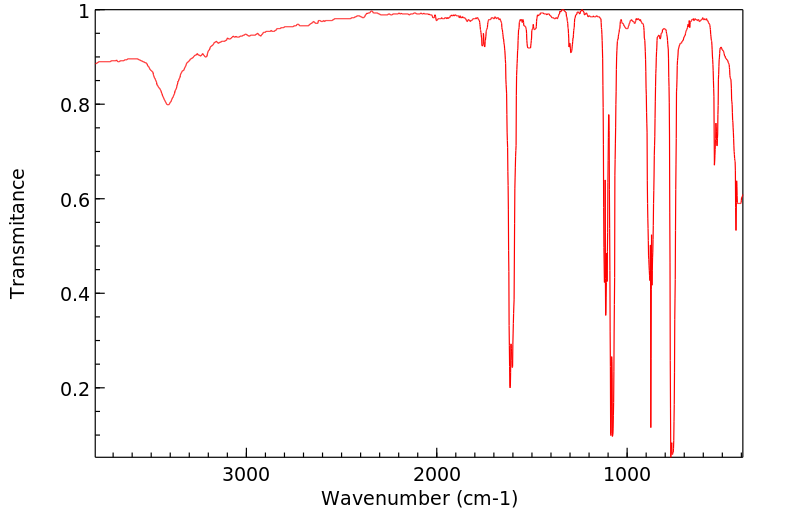1-溴-1-氯乙烯 | 17759-85-2
中文名称
1-溴-1-氯乙烯
中文别名
——
英文名称
1-Brom-1-chlor-ethylen
英文别名
1-Brom-1-chlor-aethylen;Ethene, 1-bromo-1-chloro-;1-bromo-1-chloroethene
CAS
17759-85-2
化学式
C2H2BrCl
mdl
——
分子量
141.395
InChiKey
DQIRHMDFDOXWHX-UHFFFAOYSA-N
BEILSTEIN
——
EINECS
——
-
物化性质
-
计算性质
-
ADMET
-
安全信息
-
SDS
-
制备方法与用途
-
上下游信息
-
文献信息
-
表征谱图
-
同类化合物
-
相关功能分类
-
相关结构分类
计算性质
-
辛醇/水分配系数(LogP):2.4
-
重原子数:4
-
可旋转键数:0
-
环数:0.0
-
sp3杂化的碳原子比例:0.0
-
拓扑面积:0
-
氢给体数:0
-
氢受体数:0
SDS
反应信息
-
作为反应物:描述:参考文献:名称:Henry, Bulletin de la Societe Chimique de France, 1884, vol. <2>42, p. 262摘要:DOI:
-
作为产物:参考文献:名称:Dynamics of endoergic substitution reactions. II. Br+{C2H2Cl2}→Cl+{C2H2ClBr}摘要:We have extended the crossed beams studies described in the preceding paper to the reactions of Br atoms with 1,1- and trans-dichloroethylene. The shapes of the product translational energy distributions and excitation functions for both reactions support our previous conclusion that Cl elimination from Br–R–Cl collision complexes can compete with Br elimination only in the limit that few vibrational modes of the complex are active in energy redistribution. The substitution cross section for the Br+CH2CCl2 reaction is considerably lower than that for the Br+trans-CHClCHCl reaction in the collision energy range 15–25 kcal/mol, suggesting that steric effects play a dominant role in determining the relative magnitudes of the cross sections.DOI:10.1063/1.455440
文献信息
-
Free-Radical Reactions of Diazomethane with Reactive Bromopolychloroalkanes作者:W. H. Urry、Norman. BilowDOI:10.1021/ja01063a032日期:1964.5.5
-
Gmelin Handbuch der Anorganischen Chemie, Gmelin Handbook: Si: MVol.C, 51, page 146 - 149作者:DOI:——日期:——
-
Biltz,H., Chemische Berichte, 1902, vol. 35, p. 3527作者:Biltz,H.DOI:——日期:——
-
Denzel, Justus Liebigs Annalen der Chemie, 1879, vol. 195, p. 206作者:DenzelDOI:——日期:——
-
Halogen Substituted Vinyltrichlorosilanes and Ethyltrichlorosilanes作者:Courtland L. Agre、Wallace HillingDOI:10.1021/ja01135a055日期:1952.8
表征谱图
-
氢谱1HNMR
-
质谱MS
-
碳谱13CNMR
-
红外IR
-
拉曼Raman
-
峰位数据
-
峰位匹配
-
表征信息
同类化合物
(反式)-4-壬烯醛
(s)-2,3-二羟基丙酸甲酯
([1-(甲氧基甲基)-1H-1,2,4-三唑-5-基](苯基)甲酮)
(Z)-4-辛烯醛
(S)-氨基甲酸酯β-D-O-葡糖醛酸
(S)-3-(((2,2-二氟-1-羟基-7-(甲基磺酰基)-2,3-二氢-1H-茚满-4-基)氧基)-5-氟苄腈
(R)-氨基甲酸酯β-D-O-葡糖醛酸
(5,5-二甲基-2-(哌啶-2-基)环己烷-1,3-二酮)
(2,5-二氟苯基)-4-哌啶基-甲酮
龙胆苦苷
龙胆二糖甲乙酮氰醇(P)
龙胆二糖丙酮氰醇(P)
龙胆三糖
龙涎酮
齐罗硅酮
齐留通beta-D-葡糖苷酸
鼠李糖
黑芥子苷单钾盐
黑海棉酸钠盐
黑木金合欢素
黑曲霉三糖
黑介子苷
黄尿酸8-O-葡糖苷
麻西那霉素II
麦迪霉素
麦芽糖脎
麦芽糖基海藻糖
麦芽糖1-磷酸酯
麦芽糖
麦芽四糖醇
麦芽四糖
麦芽十糖
麦芽六糖
麦芽五糖水合物
麦芽五糖
麦芽五糖
麦芽五糖
麦芽三糖醇
麦芽三糖
麦芽三糖
麦芽三塘水合
麦芽七糖水合物
麦芽七糖
麦法朵
麦可酚酸-酰基-Β-D-葡糖苷酸
麦利查咪
麝香酮
鹤草酚
鸢尾酚酮 3-C-beta-D-吡喃葡萄糖苷
鸡矢藤苷







